Quito: A Colonial Jewel in the Andes
What Should I See in Quito? The astonishing mountain views, the hilly terrain, the layout of the ever-extending city and surrounding valleys, the prominent smell of fresh baked goods around every corner, the temperate climate, and stunning skyline, simply put, are like no other.
It is also home to one of the best-preserved Historic Centers in the Americas. During the last decade, the Historic Center of Quito has flourished considerably, drawing artists, entrepreneurs, residents, and business owners that have been working hard to restore and repurpose buildings in this one-of-a-kind UNESCO World Heritage Site. Unique new galleries, shops, and cafés are now found around every corner, dramatically transforming the Old Town into a place replete with beautiful parks and walkways.
Awaken to history, culture, and tradition
As the original center of the city, the historic district of Quito is a veritable treasure chest full of gorgeous historical sites that allow you to truly experience Quito as a city, community, and culture. Being well-positioned to really take advantage of the short walking distances between so many different and interesting sites is key to experiencing this magical spot. Just a couple of minutes from San Francisco Plaza, which is right where Casa Gangotena sits, one can find some of the city’s most interesting museums, churches, and shops. The best part is that, by being in the heart of the Old Town, you won’t have to deal with cabs, traffic lights, and parking. You can just explore on foot, at your leisure!
The following are 15 reasons for why you should definitely consider staying in the Historic Quarter of Quito:
#1: Casa Gangotena Boutique Hotel
As one of the earliest mansions in Quito, this renovated boutique hotel in Quito offers a fascinating bit of insight into the burgeoning capital’s history, right when the city was beginning to grow and thrive over the course of the following centuries. Now a boutique hotel and restaurant, its epic history, soaring ceilings, and original artwork offer guests a unique place to experience Quito in luxury and style. It also serves as one of the most pivotal and convenient spots to explore the Old Town from.
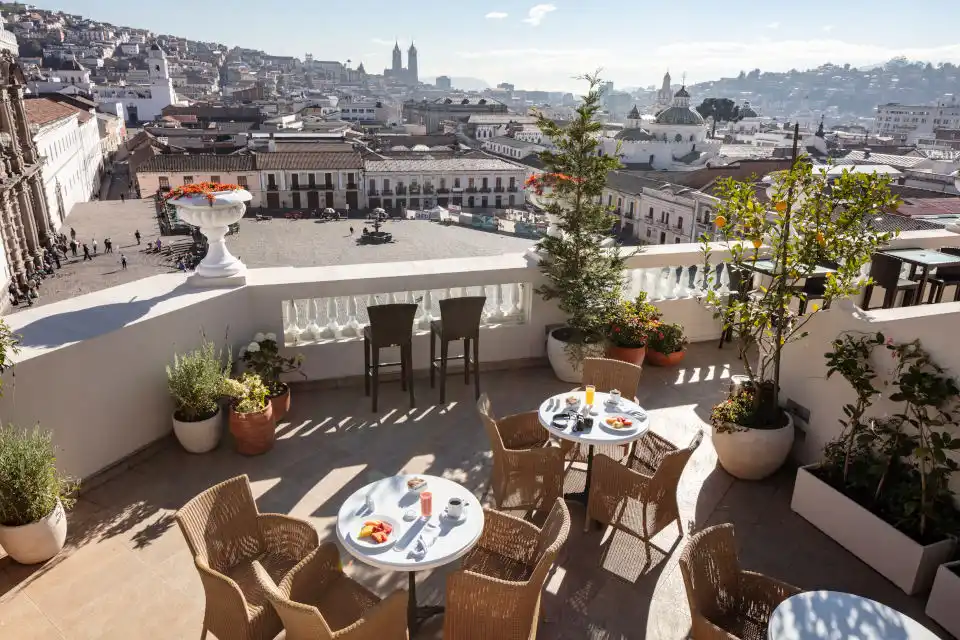
From its exquisite rooftop terrace, one can enjoy an excellent view over the San Francisco Plaza and the historic district while savoring a handcrafted signature cocktail or delicious coffee… all before heading out to explore the secrets and wonders of the Old Town. The comfortable lounge area, too, serves as a great place to cool down and enjoy one of the bar’s mouth-watering appetizers, while the spacious restaurant offers premium Ecuadorian dishes (with a terrific twist!) and first-class service.
Note: Casa Gangotena also offers unparalleled, exclusive tours that further deepen your adventure in the capital, as well as luxurious experiences such as massages and gourmet treats throughout the day
#2: San Francisco Church & Convent
The immense San Francisco Church and Convent are hard to miss as they proudly stand together, side-by-side, right at the head of the San Francisco Plaza. Wide, centuries-old stone stairs lead up to the towering wooden doors of the church, which covers three hectares (7.5 acres) and took over 200 years to build. Upon passing through the entranceway, the eyes are assaulted by a rich sea of colors inside. The roof, walls, and altar are all covered in gold, crimson red and blue. On the walls, ecclesiastical scenes are portrayed in incredible historic oil paintings and statues.
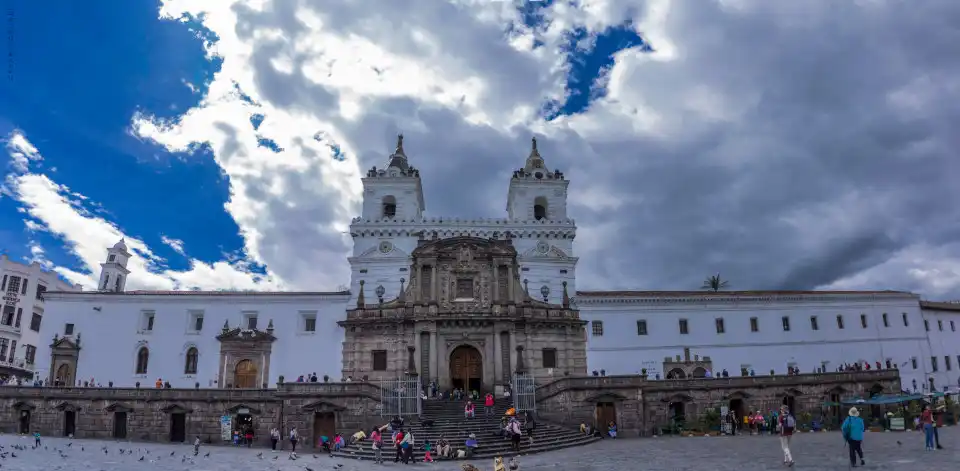
Next to the church is the convent, which shares the same stately white and stone pillars. As you enter the inner sanctum of this still active convent, the aromas of an impeccably kept courtyard overflowing with colorful flowers and plants waft over you, immediately taking you to another era and filling your senses with wonder.
#3: La Iglesia de la Compañía (The Church of the Society of Jesus)
Although the outside of the Iglesia de la Compañía may appear understated with its baroque stone-cut facade, the two-story twisting pillars hint at the fact that it is a cut above the rest. Upon entering this Jesuit church, you can see why–the entire nave is covered by gold leaf, gilded plaster, and wooden carvings.
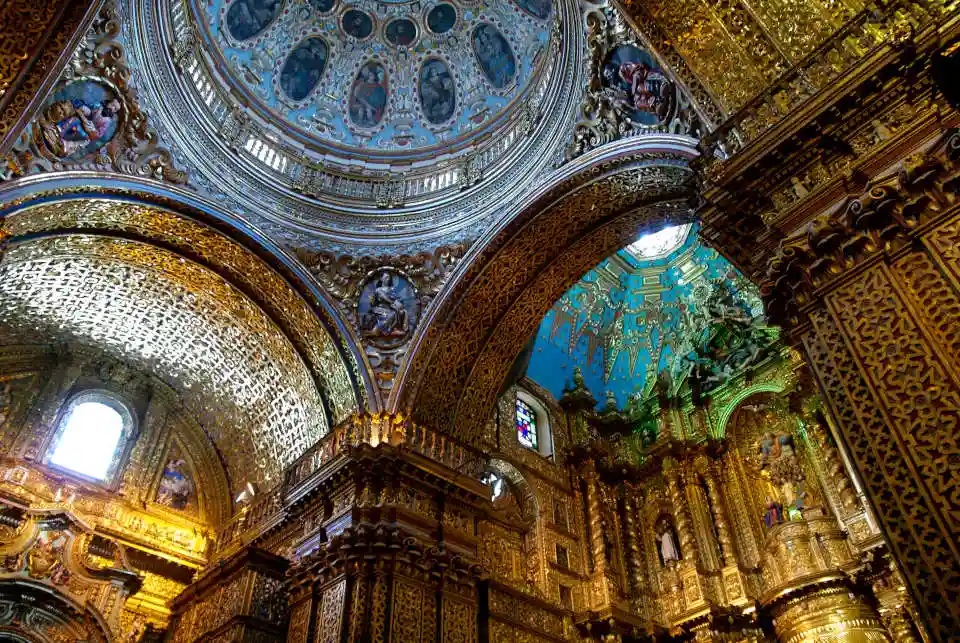
The effect is breathtaking as each individual and priceless piece of art begins to stand out. La Compañía is Quito’s most ornate church and is internationally renowned for its gilded uniqueness. Some people say that it is the world’s most beautiful church, but an opinion must be withheld until you enter the church and experience it for yourself.
#4: Arco de la Reina (The Queen’s Arch)
The Queen’s Arch is easily identified by its vivid orange and white colors as it soars over the narrow street right outside of the Carmen Alto Convent. It was originally built in 1726 to protect the indigenous devotees of an old chapel from the rain. A glass display area now stands where the chapel used to be located, containing a vibrant oil painting of Nuestra Señora de los Ángeles.
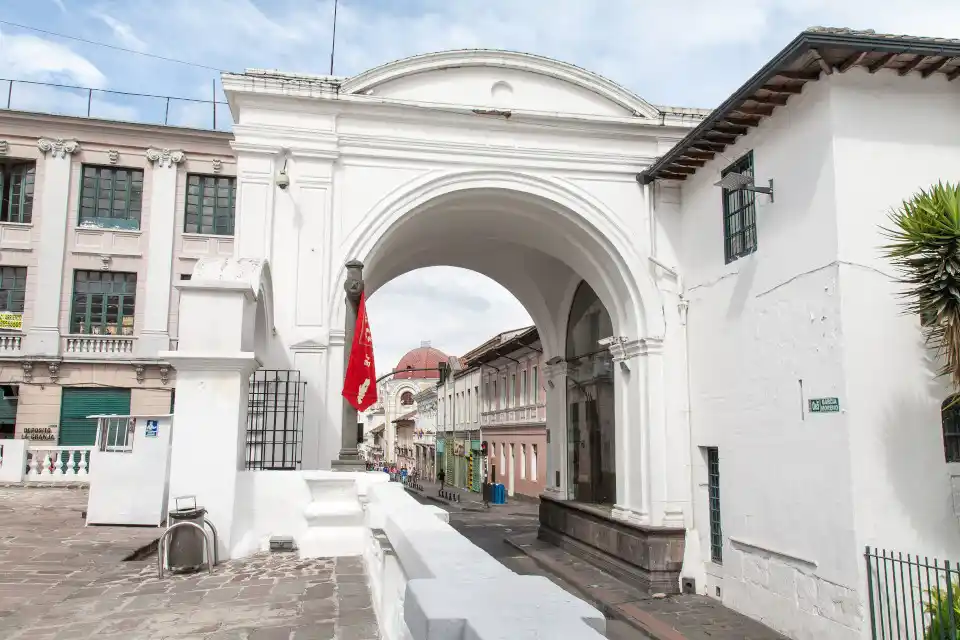
#5: Santo Domingo Church
On the outskirts of the historic district, this church looms over the Santo Domingo Plaza. A bona fide amalgamation of architectural styles including Baroque, neoclassical, and Moorish influences, it was built by the Dominicans and modified by Italian priests. You would think that stitching together so many cultures, nationalities, and styles would cause confusion, but the end result clearly defines elegance.
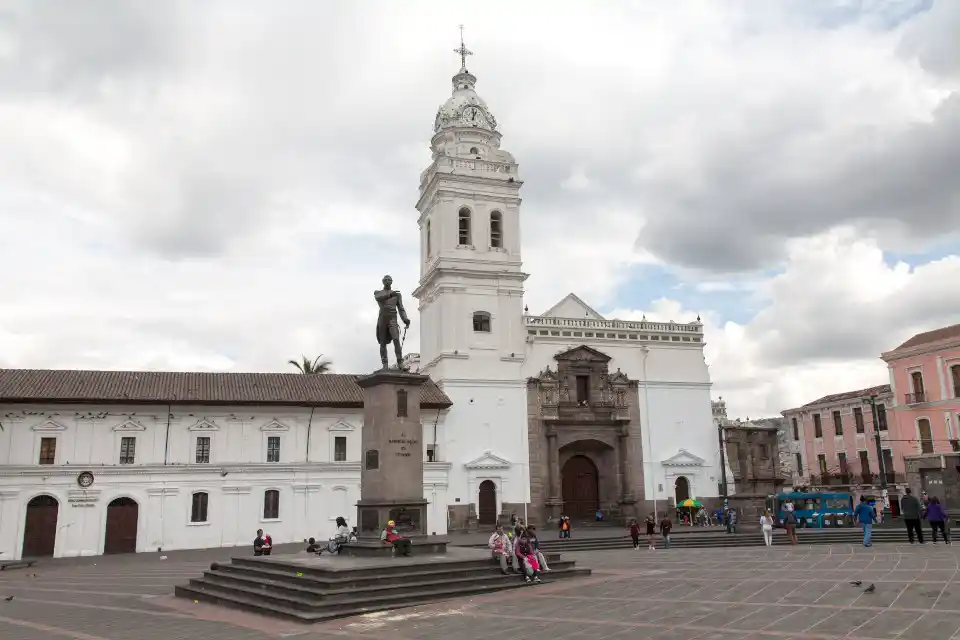
The church is a long, white building with an entrance clearly defined by tall and arched wooden doors. Inside, an explosion of colors bursts out in the form of carvings, reliefs, and gorgeous frescoes. The finite details of the Lady of Rosary chapel are worth a close inspection as every inch is carefully painted and crafted in gold, royal red, and spirals of green.
#6: Centro Cultural Metropolitano (The Metropolitan Cultural Center)
The Centro Cultural Metropolitano offers something special and unique for everyone. It shares the same building with a library and a restaurant, making the atmosphere here rather intellectual and inviting.
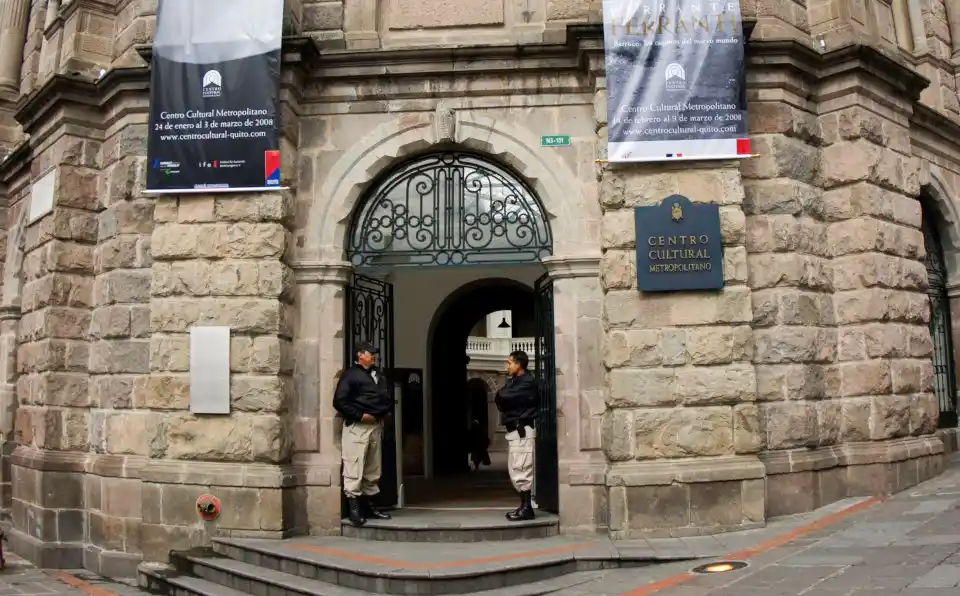
Its large, internal plaza is covered by an enormous glass dome that is impressive enough on its own, but the Centro Cultural Metropolitano offers visitors unprecedented, thought-provoking exhibitions, ranging from art to literature to history (and anything in between), creating a magical journey between the various, mood-lit rooms on its first and second floors.
#7: Palacio de Gobierno (The Government Palace)
The Government Palace presides over the Plaza Grande with all of the loftiness and grandiosity that a single building can encompass. The brilliant, white palace, dominates an entire city block in the middle of Quito’s historic district and is easily identifiable from every angle by the gigantic Ecuadorian flag that waves around proudly from its rooftop. Ceremonial guards stand attentively on either side of the grand entrance, and everything about the atmosphere here invokes military discipline, precision, and honor.
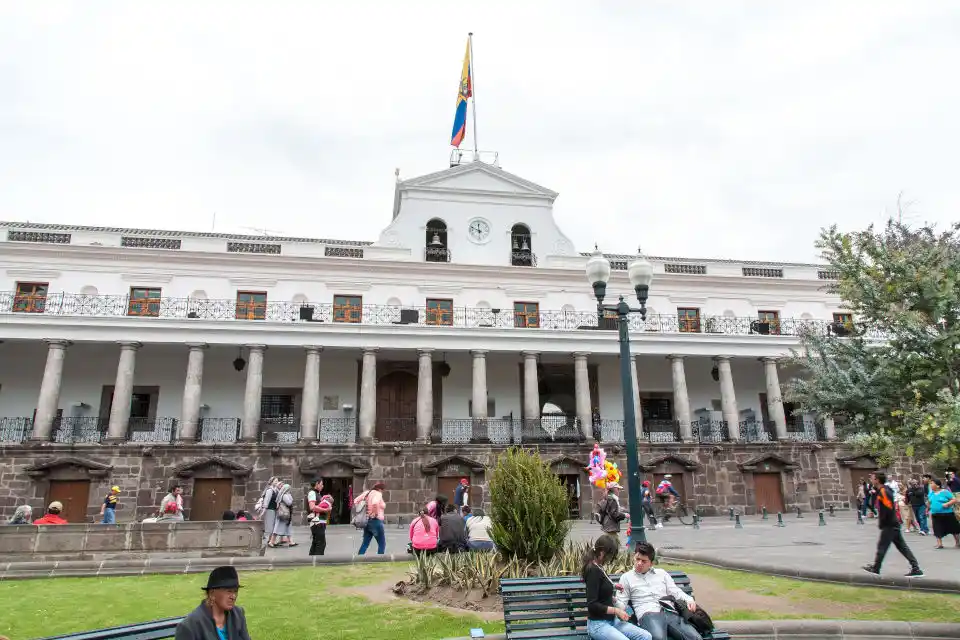
Right underneath the double-balconied building, small bustling shops sell everything from popsicles to Christmas decorations. A tour through the palace gives visitors a deeper understanding of how Ecuador is run, and even allows you to take a few token photos with the statue-like guards.
#8: Catedral Metropolitana de Quito (Metropolitan Cathedral of Quito)
You can tell the Cathedral is an important piece of Quito’s history and people because it was built on the original main square of Quito back in 1535. The stark white walls are offset by wide stone stairs and pillars that surround the front entrance. Once inside the church, you’ll be awe-struck by the beauty of everything you lay your eyes on.
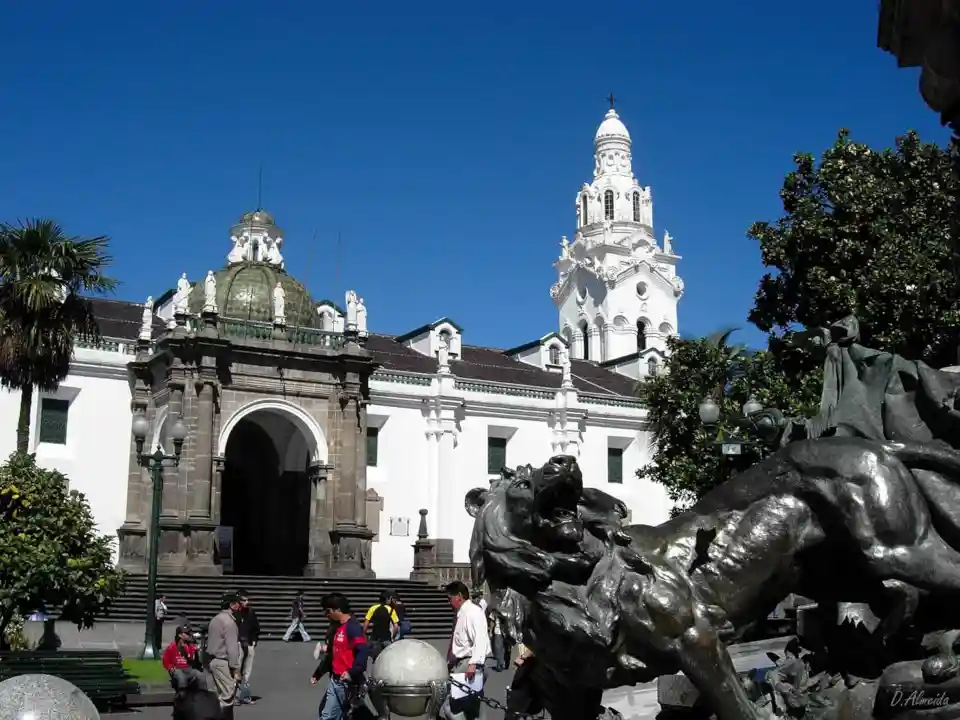
The theme of stone pillars continues inside, but is combined with generous wooden carvings and paneling on every wall. Golden candelabras hang at every corner and small arches lead you toward the main altar, which itself is bathed in rich hues that consist of green, gold, and red. All of this leads the eye to the main and central painting of the church – The Virgin Mary. But don’t forget to look up! The dome above the altar is brightly decorated with angels floating in the clouds around the golden skylight.
#9: Museo del Carmen Alto (Carmen Alto Museum)
Attached to the double-towered and timeworn Carmen Alto Church is the museum of the same name. This museum gives off a reverent and historical feeling even before visitors walk through its doors: the large square foyer outside the museum leads you to believe that you are truly visiting a special and privileged place.
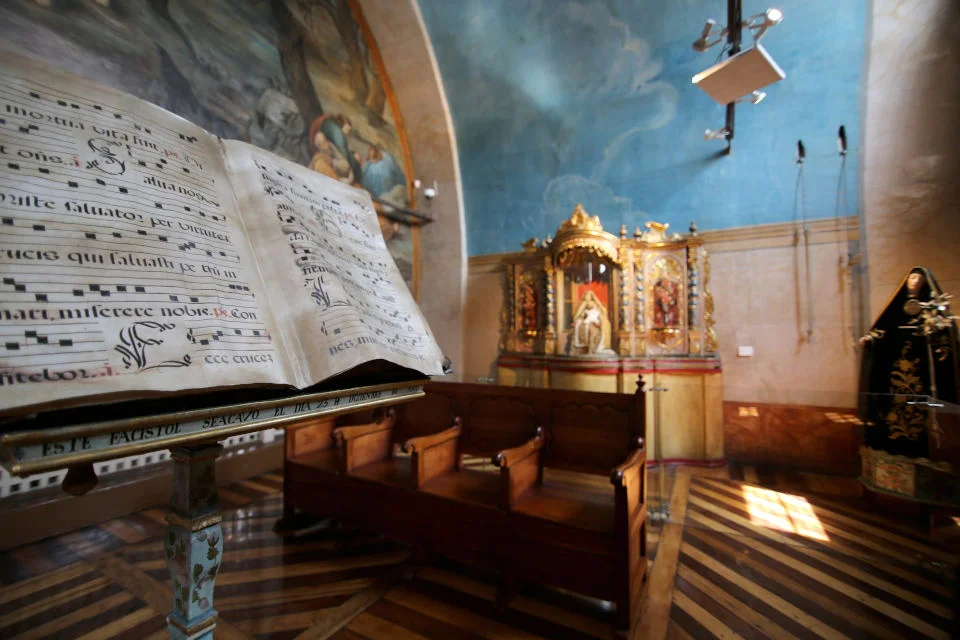
Once inside, you’ll find that the museum aims to reflect on Carmelite Heritage Art, the daily lives of the sisters of the Descalza Carmelite Order, and the life of Mariana de Jesus – a saint and Ecuadorian heroine. The original wooden doors still hang at each doorway, and exposed, raw logs line the immaculate white ceilings. Each piece has been carefully and lovingly displayed by devout caretakers.
#10: Museo Casa del Alabado (The Acclaimed Pre-Columbian Art Museum)
The Casa del Alabado museum may appear small upon entering, but don’t let that fool you. This Ecuadorian pre-Columbian art museum displays some of the city’s most precious and valuable artifacts. In total, the museum hosts 5,000 archaeological pieces with 500 of them continuously on display.
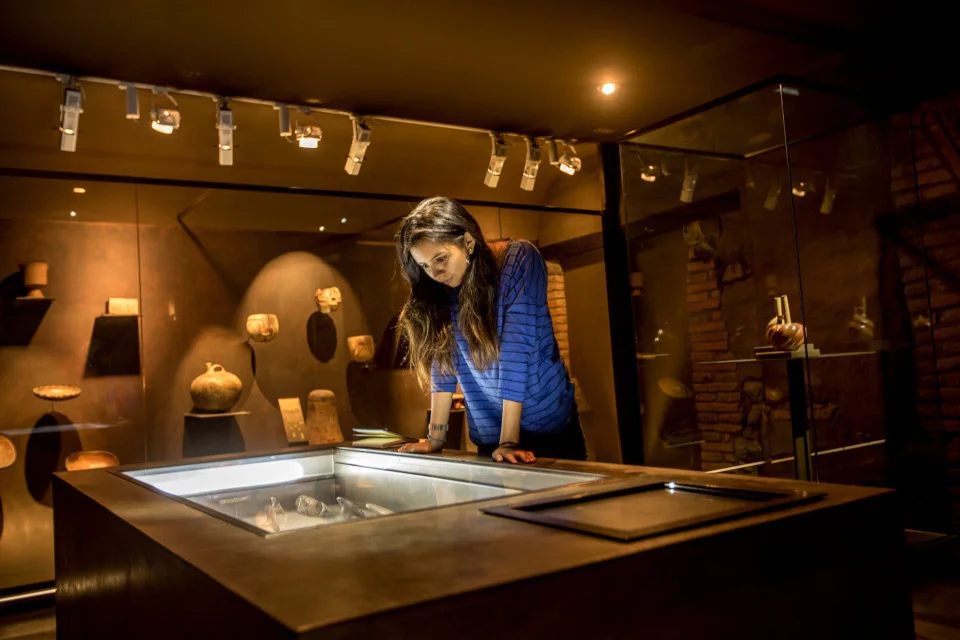
These pieces are all shown, quite fittingly, within this tastefully-restored colonial house that was built in the 17th century. The walls are built with exposed stone, which brings the pieces on display to life and lets their stories live on. From the handcrafted wooden balcony, the view over the house’s central and open courtyard offers a refreshing bit of respite from the bustling city outside.
#11: Basílica del Voto Nacional (Basilica of the National Vow)
La Basílica del Voto Nacional dominates virtually every existing view of Quito’s historic district. This enormous neo-Gothic church is the largest of its kind in the Americas, with two spire-like towers that rise far above the front of the church, giving it a near-ominous and powerful appearance. Hidden meanings and details are spread throughout the Basilica, and even the gargoyles on the side of the church represent different Ecuadorian animals including iguanas, armadillos, and Galapagos giant tortoises.
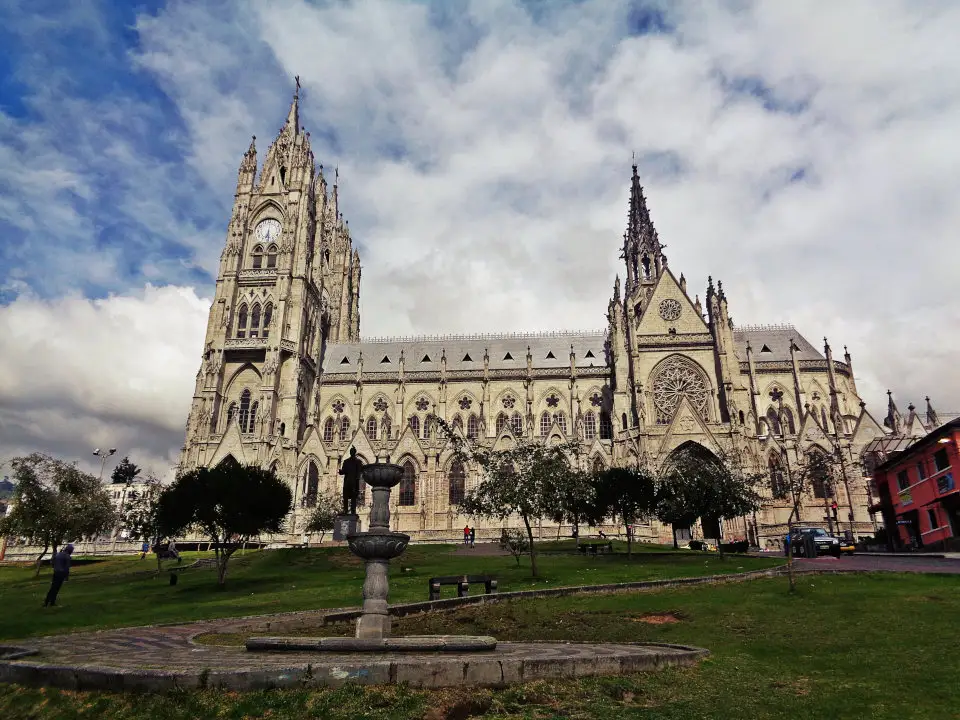
The circular rose window showers the chapel in a mystical dance of colors, which contrast against the stark grey stones that were used to build it. The spiral stairways inside the church lead to the top of the towers, offering visitors a breathtaking view of Quito and its surrounding mountains. As you cross the catwalk along the inside ridge of the roof, it is easy to wonder just how many stories this enormous building holds. Although the ladders up to the smaller tower seem death-defying, the view is even more spectacular than the one at the top of the spiral stairways. This church not only offers a unique perspective into Quito’s history, it also offers visitors a small little adventure in the form of architectural exploration.
#12: Teatro Nacional Sucre (The Sucre National Theater)
All stops were pulled to make sure that the outside of the building illustrated the pomp and splendor that the Teatro Nacional Sucre holds within. Its exterior façade is snow white, which only further emphasizes the golden highlights and wooden frames of the arched windows.
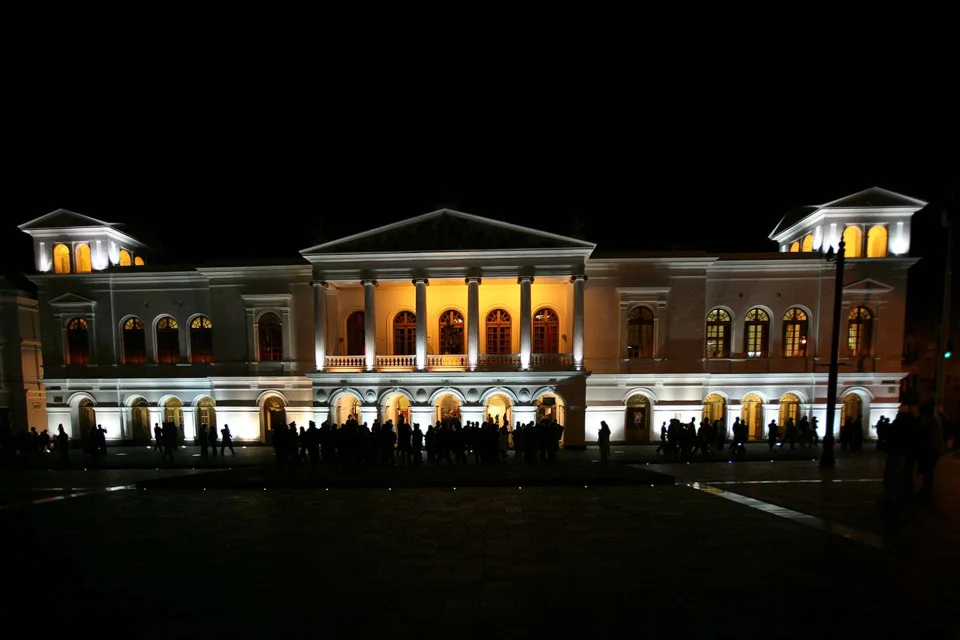
The iconic pillars lead your gaze up to the gable, where golden statues depict a scene of Apollo and other Greek gods. The theater itself offers three-tiered, red velvet seating with pale yellow walls and an enormous crystal chandelier overseeing it all. The Teatro Nacional Sucre offers both local and international musical performances ranging from jazz to classical – so rest assured that there is something for everyone to enjoy.
#13: Teatro Bolívar (Bolivar Theater)
Teatro Bolívar is immediately recognizable as a theater from the outside – the large vertical backlit sign announcing ‘Bolívar’ and the circular, pink, and original ticket booth say it all. In the main entrance, a huge chandelier hangs down from a grey sea of hanging silk and above a mosaic-tiled floor, announcing that this experience is certainly unique.
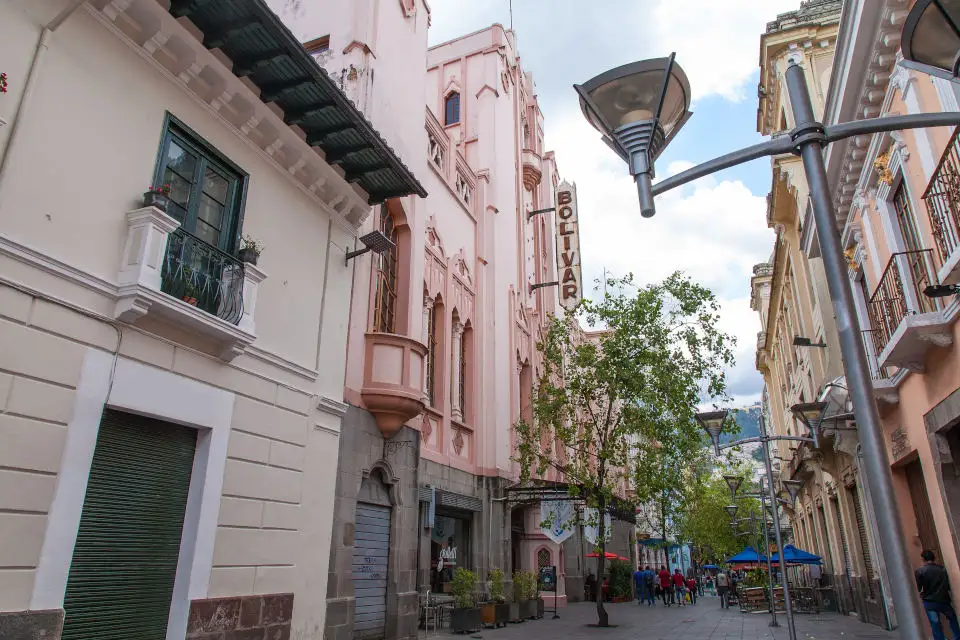
The theater hosts a large variety of performances throughout the year in an atmosphere of both grandeur and elegance. The red leather seats lead up to a large stage fringed with royal red velvet curtains. Golden arches line either side of the theater, accented with the same royal red. All there is to do is take your seat and enjoy the show!
#14: Calle La Ronda (La Ronda Street)
You’ve probably heard of a boutique hotel or restaurant, but have you ever heard of a boutique street? La Ronda squeezes everything a tourist could ever dream of into a cobblestone lane that’s lined with colorful buildings and balconies that have been cheerfully decorated with overhanging flowers and Ecuadorian flags. The shops offer every handcrafted souvenir possible, and even host workshops on how some of their wares are made!
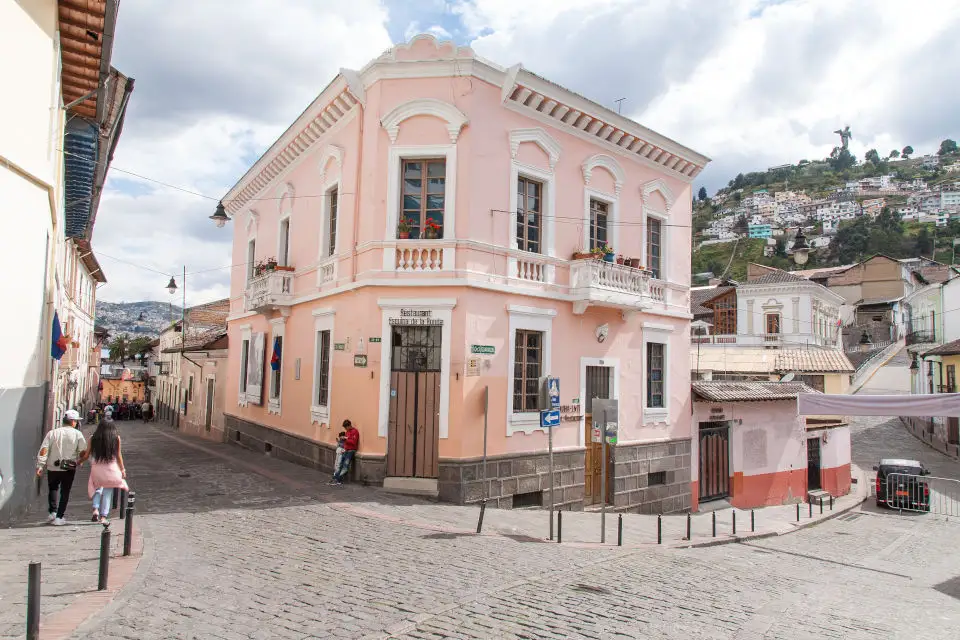
A particularly well-known man makes spinning tops, and multiple shops are happy to show visitors how their chocolate products are crafted. A sense of festivity can always be found here, especially at night when the street awakens as the bars and restaurants begin playing live music and offering traditional Ecuadorian drinks and food, including canelazos and empanadas. The streets, too, are often filled with all sorts of performances and carnival-style games for the kids.
#15: Barrio San Marcos (San Marcos Neighborhood)
When a neighborhood has a one-of-a-kind café inside of an ancient church as one of its most prominent features, you know that you are in for a treat. The picturesque neighborhood of San Marcos offers visitors an authentic experience of life in Quito, inviting you down its streets that are flanked by green-, pink- and/or blue-painted buildings, each of which have balconies that overflowing with brightly-colored flowers.
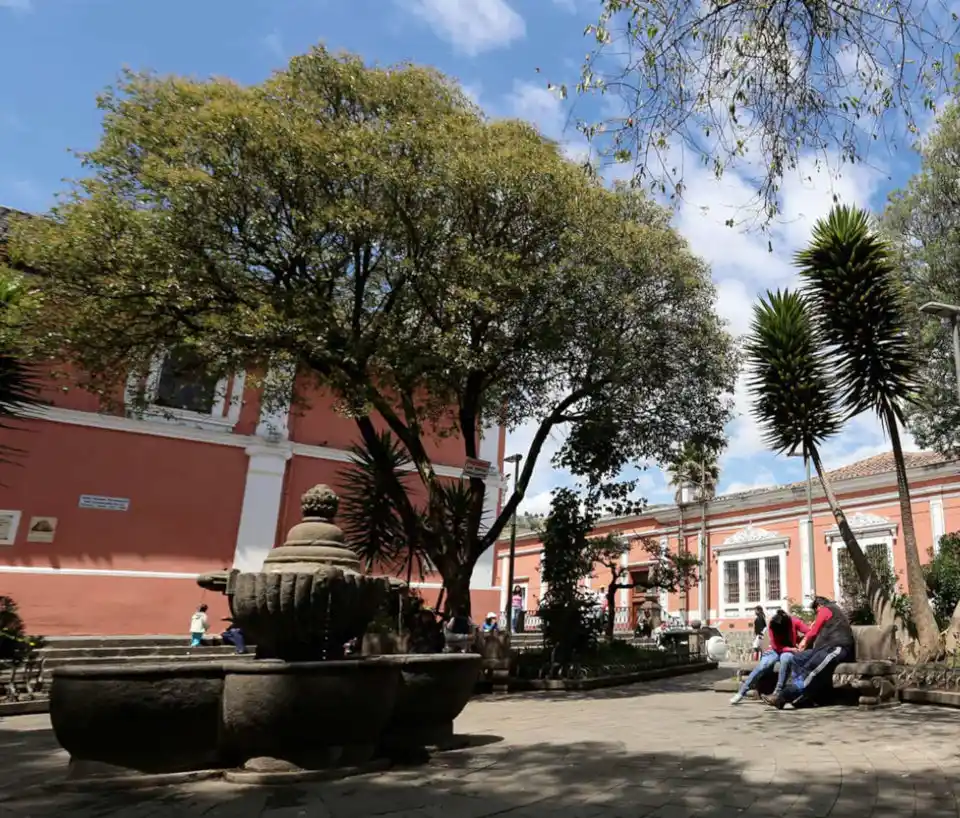
The owners of fruit and vegetable stalls welcome you in, while children playing on the street smile and wave. As you wander throughout the neighborhood, you can stop at any of the various museums and, for when you finally get tired, there are many cafes and restaurants that offer a warm and pleasant dining experience and place to rest. The air here is always filled with relaxed laughter and chatter mixed with the aromas of fresh fruit and coffee.
When is the perfect time to visit Quito and stay in its Historic Quarter?
With the city’s renewed focus on preserving its past and planning for its future, there is no time like the present to visit this beautiful and unique place, high in the Andes Mountains of South America. The city continues to steadily modernize itself while dedicating its energy and efforts to preserving its past, all the while making this gem a welcoming and inviting place. Staying in the historic district is a surefire and easy way of experiencing the best of what Quito has to offer, including its many museums, churches, festivals, restaurants, and cafés, all within walking distance!



